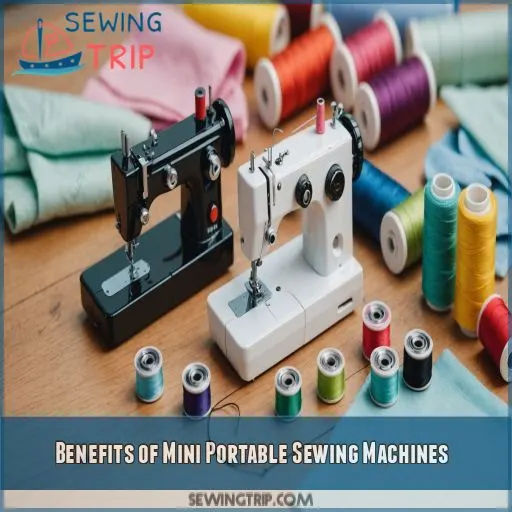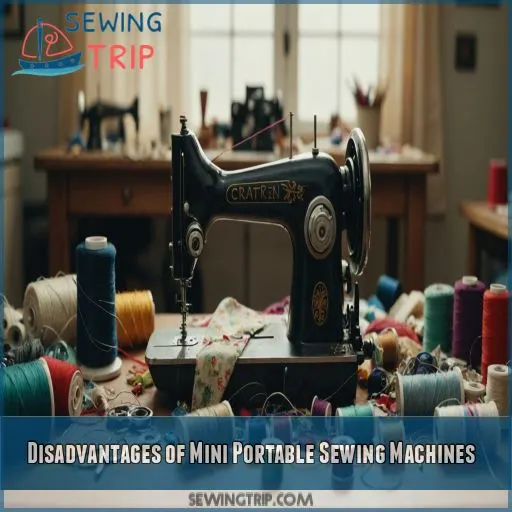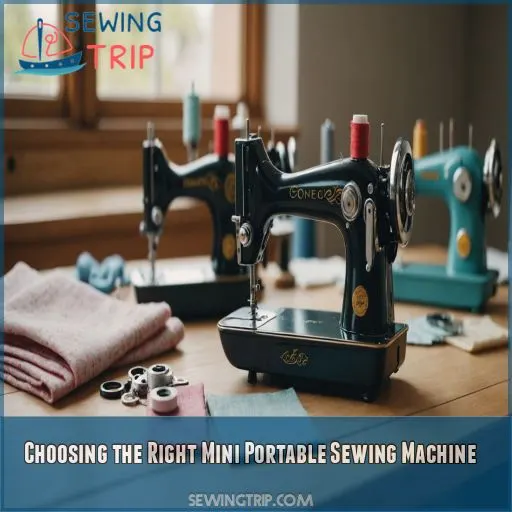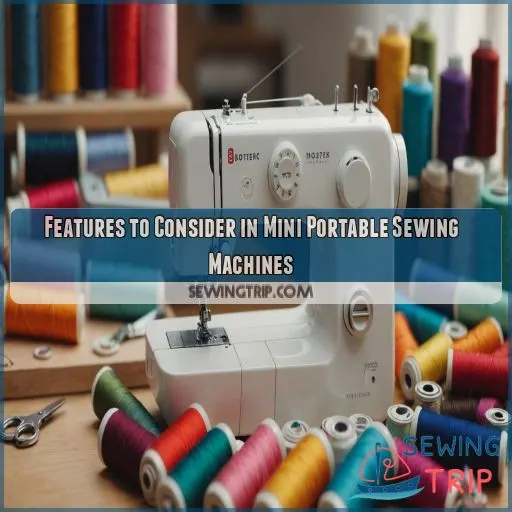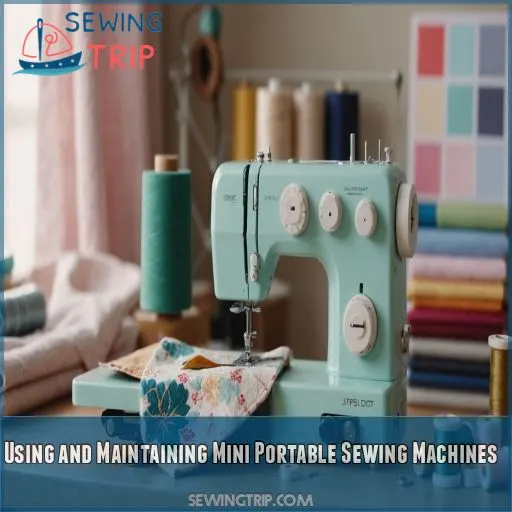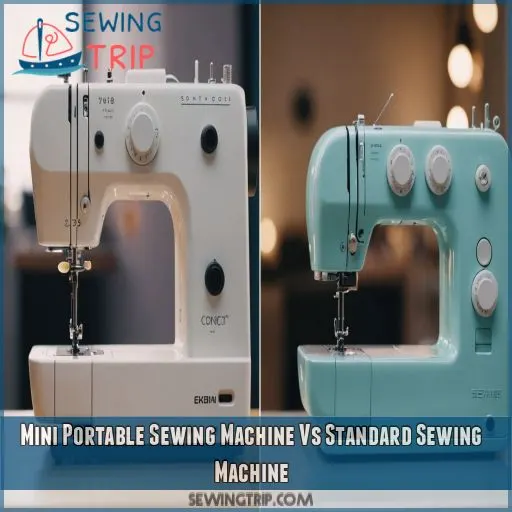This site is supported by our readers. We may earn a commission, at no cost to you, if you purchase through links.
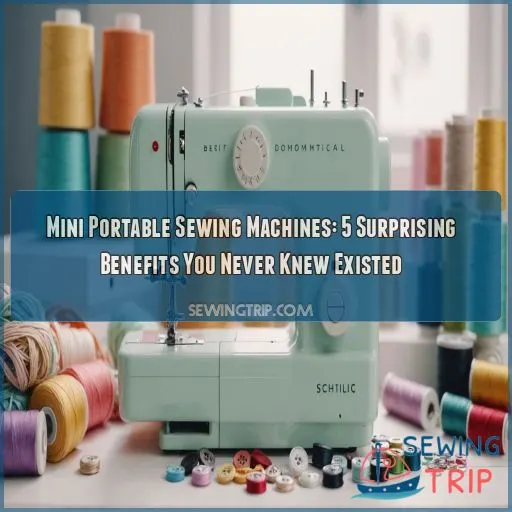
.
AsAs a a beginner beginner,, you you’ll’ll love love how how user user-friendly-friendly they they are are,, with with limited limited stitch stitch options options and and a a simple simple interface interface.. Plus Plus,, they they’re’re a a cost cost-effective-effective alternative alternative to to full full-sized-sized machines machines.
.
ButBut what what really really sets sets them them apart apart is is their their versatility versatility – – from from fixing fixing torn torn pages pages to to creating creating handmade handmade gifts gifts.
. OfOf course course,, there there are are some some trade trade-offs-offs,, like like limited limited features features and and noise noise level level.. But But trust trust us us,, the the benefits benefits far far outweigh outweigh the the drawbacks drawbacks..
Table Of Contents
- Key Takeaways
- Benefits of Mini Portable Sewing Machines
- Disadvantages of Mini Portable Sewing Machines
- Choosing the Right Mini Portable Sewing Machine
- Features to Consider in Mini Portable Sewing Machines
- Using and Maintaining Mini Portable Sewing Machines
- Mini Portable Sewing Machine Vs Standard Sewing Machine
- Frequently Asked Questions (FAQs)
- Conclusion
Key Takeaways
- You’ll love how mini portable sewing machines are perfect for beginners, with their easy-to-use interface and limited stitch options that won’t overwhelm you—plus, they’re super portable, so you can practice wherever you go!
- When life throws you a sewing curveball, a mini portable sewing machine can be your ace in the hole, making on-the-go repairs and small-scale crafting a breeze, so say goodbye to tedious hand-stitching and hello to professional-looking results in no time.
- Don’t worry about breaking the bank—mini portable sewing machines are a cost-effective alternative to full-sized machines, with prices starting from under $20, making them perfect for small projects, repairs, or beginners, and you’ll save on storage space and energy consumption too.
- While mini portable sewing machines have their limitations, such as struggling with thick or thin fabrics, noisy operation, and durability concerns, the benefits far outweigh the drawbacks, so if you’re looking for a reliable sidekick for your sewing adventures, a mini portable sewing machine is definitely worth considering.
Benefits of Mini Portable Sewing Machines
You’re probably thinking that sewing machines are bulky and only for serious crafters, but mini portable sewing machines are about to change your mind. With their compact size and user-friendly design, these tiny powerhouses offer a range of benefits that’ll make you wonder how you ever managed without one.
Portability and Convenience
- Travel Sewing Kits: Take them on-the-go for emergency repairs.
- Compact Storage Options: Store them in small spaces, like drawers or shelves.
- Lightweight Designs: Weighing around 5 pounds, they’re easy to carry.
- Portable Cases: Many come with mobile sewing stations for effortless transport.
Easy to Use for Beginners
You’re a beginner, and the thought of using a sewing machine makes you nervous. Don’t worry, mini portable sewing machines are here to help! With their easy-to-use interface and limited stitch options, you can focus on mastering the basics. Here’s a quick rundown of what to expect:
| Feature | Description | Benefit |
|---|---|---|
| Straight Stitch | Simple, versatile stitch | Great for beginners |
| Tension Control | Adjust thread tension with ease | Reduces thread breakage |
| Mini Size | Compact, lightweight design | Easy to handle and store |
These machines are perfect for learning the ropes without feeling overwhelmed. Plus, they’re super portable, so you can practice wherever you go!
Suitable for Quick Repairs and Small Projects
When life throws you a sewing curveball, a mini portable sewing machine can be your ace in the hole. Whether it’s mending a torn seam or whipping up a quick DIY project, these compact wonders make on-the-go repairs and small-scale crafting a breeze. Say goodbye to tedious hand-stitching and hello to professional-looking results in no time.
Cost-Effective Alternative to Full-Sized Machines
You’re probably thinking, "Mini portable sewing machines can’t possibly be as cost-effective as full-sized ones, right?" Think again! These compact cuties offer impressive savings without sacrificing functionality. With prices starting from under $20, they’re perfect for small projects, repairs, or beginners. Plus, you’ll save on storage space and energy consumption – a win-win for your wallet and the environment!
Versatility in Crafting and DIY Projects
Mini portable sewing machines are a dream for crafting and DIY enthusiasts.
They offer a range of creative possibilities, from DIY fashion tips to home decor projects.
With these machines, you can whip up mini quilts, upcycle old materials, or create custom accessories with ease.
Get ready to tap into your inner maker and take your sewing skills on-the-go!
Disadvantages of Mini Portable Sewing Machines
As you’re considering a mini portable sewing machine, you should acknowledge the potential downsides.
After all, you want to make an informed decision that suits your sewing needs.
In this section, we’ll explore the disadvantages of mini portable sewing machines, from limited features and functionality to durability concerns.
This will allow you to weigh the pros and cons and decide if one of these compact machines is right for you.
Limited Features and Functionality
Mini portable sewing machines can make you feel like you’re "sewing with one hand tied behind your back" due to their limited features and functionality. Here are three key limitations:
- Basic Stitch Options: Most mini portable sewing machines only offer a few basic stitches, which can limit your creativity.
- Limited Fabric Handling: They often struggle with thick or slippery fabrics, making it tough to work with anything other than cotton or polyester.
- Noisy Operation Issues: These machines can be surprisingly loud, which might be a problem if you plan to use them in a shared space or during quiet hours.
Not Suitable for Thick or Thin Fabrics
When working with mini portable sewing machines, you’ll encounter fabric limitations. These machines aren’t designed for thick or thin fabrics, which can cause tension issues and uneven stitches. Here’s a quick rundown of the limitations:
| Fabric Type | Thickness Issues | Thin Fabric Problems |
|---|---|---|
| Denim | May cause tension issues | Not applicable |
| Cotton | Can handle moderate thickness | May pucker or gather |
| Silk | Not suitable for thick silk | May be too delicate |
| Knits | Can handle moderate thickness | May be too stretchy |
Keep these limitations in mind to avoid frustrating sewing experiences.
May Struggle With Multiple Layers or Heavier Materials
When working with multiple layers or heavier materials, mini portable sewing machines may struggle to keep up. You might notice issues with fabric bunching, uneven stitches, or even broken needles. To mitigate these problems, consider the following:
- Use a machine with adjustable foot pressure to accommodate thicker fabrics.
- Choose a machine with an extra high presser foot lift for easier layering.
- Select a machine with a drop feed system for smoother fabric movement.
- Adjust the needle position and bobbin thread tension control for best performance.
Noise Level Compared to Standard Sewing Machines
Mini portable sewing machines can be a bit noisier than their standard counterparts.
To minimize the noise, look for machines with motor volume control or silent stitching methods. Some models also feature sound dampening techniques to reduce the noise level.
However, if quiet sewing is a top priority, a standard machine might be a better fit.
Durability Concerns Compared to Standard Machines
In terms of durability, mini portable sewing machines can be a concern. With more plastic parts and smaller components, they may not withstand heavy use like standard machines. Material limitations and maintenance requirements can also impact wear resistance. However, many brands offer quality components and repair options, making it essential to research and invest in a reputable model.
Choosing the Right Mini Portable Sewing Machine
You’re ready to join the mini portable sewing machine fan club, but with so many options out there, You’re ready to join the mini portable sewing machine fan club, but with so many options out there, Achieving Perfect Fits choosing the right one can be overwhelming.
. To make the right pick, consider factors like power source, ease of use, included accessories, durability, and top brands – and don’t worry, we’ve got the lowdown to help you make an informed decision.
Power Source Options: Battery or Manual
In terms of power source options for your mini portable sewing machine, you’ve got two main choices: battery or manual. Battery life expectancy varies, but you can expect around 4-6 hours of use. Manual crank benefits include reliability and no battery replacement costs. Consider your needs – if you’re always on-the-go, a battery-powered machine might be best.
Importance of Ease of Use and Intuitive Controls
When choosing a mini portable sewing machine, consider the ease of use, especially if you’re a beginner or have limited dexterity.
A user-friendly control panel is essential for a hassle-free sewing experience. Look for machines with simple stitch selection, which allows you to easily choose the type of stitch you want to use.
Additionally, a machine with needle up/down buttons and an intuitive knee lift or bobbin winding mechanism can make a big difference. These features enable you to easily manage your thread and fabric, even in a small workspace.
Consideration of Included Accessories and Features
When shopping for a mini portable sewing machine, consider the included accessories and features that’ll make your sewing experience smoother. Look for thread cutter options, Look for thread cutter options, a sewing patch kit with various needles and threads, and bobbin winding tools.
, and bobbin winding tools. A carrying case, lint brush, twin needle guard, and last stitch recall capability can also be super helpful.
Durability and Build Quality Assessment
When evaluating durability and build quality, don’t be afraid to get a little tough.
Examine machines with metal components, and check the material selection for any signs of flimsiness.
Stress testing, component analysis, and wear resistance are all key factors that should be taken into account.
You want a machine that can withstand a few bumps and drops, like a trusty sidekick.
Comparison of Top Brands and Models
Choosing the right mini portable sewing machine can be a challenging task, but don’t worry, we’re here to help!
Let’s take a closer look at a comparison of leading brands and models.
From Singer’s Stitch Sew Quick to Janome’s Fast Lane Fuchsia, we’ll analyze features, sewing tests, and portable rankings to help you make an informed decision that suits your needs.
Features to Consider in Mini Portable Sewing Machines
When shopping for a mini portable sewing machine, you’ll want to think about the features that matter most to your sewing needs and preferences. From automatic thread tension control to LED lights, we’ll break down the key features to look for in a mini portable sewing machine that will make your sewing experience efficient, enjoyable, and hassle-free.
Automatic or Manual Thread Tension Control
Let’s get a grip on thread tension control. With mini portable sewing machines, you’ve got two options: automatic or manual. Automatic is great for beginners, but manual control techniques offer more flexibility. Look for machines with adjustable tension control systems and multiple thread feed options. Mastering thread tension benefits your stitches, so take the time to get it right!
Bobbin System and Winding Mechanism
Now that you’ve mastered thread tension control, let’s talk bobbins! When choosing a mini portable sewing machine, consider the bobbin system and winding mechanism. Look for a machine with a smooth, Look for a machine with a smooth, automatic bobbin winding system and a well-designed bobbin case that allows for easy thread access and adjustable tension control, similar to the adjustable stitch capabilities found in some sergers.
. Your sewing sanity will thank you!
Feed System and Presser Foot Options
You’re in control with the right feed system and presser foot options on your mini portable sewing machine. Here are key features:
- 4-piece feed dog: Smoothly guides fabric for even stitches
- Drop feed system: Allows for free-motion sewing and intricate designs
- Presser foot lift: Effortlessly handles thick fabrics and multiple layers
- Adjustable presser foot pressure: Customizes fabric handling for the best possible results
Stitch Options and Adjustments
Now that you’ve got your feed system and presser foot options down, let’s talk stitches.
With mini portable sewing machines, you want stitch options that make your projects pop.
Look for machines with stitch length control, thread tension dials, and automatic stitch selection.
Some machines even offer stitch width variations and custom stitch settings – a textile artist’s dream come true!
LED Light and Other Convenience Features
When working on intricate projects, an LED light can be a game-changer. Look for a mini portable sewing machine with an illuminated work area and adjustable brightness. Some models even offer hands-free operation with a built-in task light. Automatic shut off is also a convenient feature worth thinking about. These perks will make your sewing experience more enjoyable and stress-free.
Using and Maintaining Mini Portable Sewing Machines
As you get ready to tap into your creativity with your mini portable sewing machine, you need to know the basics of using and maintaining it for a smooth and enjoyable sewing experience. By following some simple guidelines, By following some simple guidelines, such as using sharp tools and needles, you’ll be able to troubleshoot common issues, keep your machine in good condition, and make the most of your sewing adventures.
, keep your machine in good condition, and make the most of your sewing adventures.
Basic Operation and Safety Precautions
The fun part – getting started with your mini portable sewing machine! First, read the manual (yes, really!). Familiarize yourself with the machine’s parts, like the safety guard and bobbin winder. When handling the machine, keep your fingers away from the needle and use the built-in thread cutter. Always unplug the machine when changing the needle or adjusting thread tension.
Regular Maintenance and Cleaning Tips
Time to get your mini portable sewing machine in tip-top shape!
Regularly check thread tension to prevent tangles and breakage.
Clean the bobbin area with a soft brush and lubricate moving parts with a few drops of oil.
Replace broken needles and store your machine in a dry, cool place.
Happy sewing, and remember: a clean machine is a happy machine!
Troubleshooting Common Issues and Errors
The inevitable errors! Don’t worry, friend, we’ve all been there. Thread tension issues? Check your spool and adjust as needed. Bobbin problems? Verify it’s properly seated and wound. Machine not stitching? Inspect for blockages or tangled threads. Fabric feed errors? Adjust the presser foot. And for needle breakage, simply replace and recalibrate.
Proper Storage and Transportation
When it’s time to stash your mini portable sewing machine, grab a travel case, machine cover, or storage bag to keep it dust-free and organized. Consider investing in a hard shell case for ultimate protection. Don’t forget to corral those pesky accessories with an organizer. Proper storage and transportation will keep your machine purring like a contented kitten.
Mini Portable Sewing Machine Vs Standard Sewing Machine
When deciding between a mini portable sewing machine and a standard sewing machine, you’re likely weighing the benefits of convenience against the need for more advanced features.
This comparison will break down the key differences in size, weight, portability, features, functionality, and cost to help you decide which machine is the best fit for your sewing needs.
Comparison of Size, Weight, and Portability
Now that you know how to keep your mini portable sewing machine in top shape, let’s talk size. Compared to standard sewing machines, mini machines are incredibly compact and lightweight. We’re talking roughly 5-7 pounds versus 20-30 pounds. This portable design tradeoff means you can stash your mini machine in a closet or tote it to class with ease.
Difference in Features, Functionality, and Performance
Let’s explore the differences in features, functionality, and performance between mini portable sewing machines and standard sewing machines. You’ll notice a significant machine weight comparison, with mini machines weighing much less. Sewing speed difference is also notable, as standard machines are generally faster. However, mini machines often lack automatic features, resulting in stitch quality variation and portability tradeoffs.
Cost Comparison and Value Assessment
In terms of cost, mini portable sewing machines are the clear winner. With prices starting from around $20, they’re a fraction of the cost of standard sewing machines. But, don’t let the low price fool you – these tiny titans pack a punch in terms of value for money. It’s time to reassess your sewing budget!
Choosing the Right Machine for Your Needs
Consider your sewing skill level, Consider your sewing skill level, the type of cotton fabrics for shirts, and the space you have available.
, and the space you have available.
If you’re a beginner or work with small projects, a mini machine is perfect.
But if you’re a pro or need more features, a standard machine is the way to go.
Frequently Asked Questions (FAQs)
Is it good to buy mini sewing machine?
Imagine the thrill of whipping up a DIY dream on-the-go! Buying a mini sewing machine can be a liberating experience, offering freedom to create and repair anywhere, but weigh the pros and cons before making a stitch.
What is the disadvantage of mini sewing machine?
You’re considering a mini sewing machine, but what’re the downsides?
Well, you might find that they’re not as durable as standard machines, and honestly, they may be less durable.
They can struggle with thicker fabrics or multiple layers, and are slower than standard machines.
They also lack automation, making them trickier for beginners to use.
Do handheld portable sewing machines work?
You can get quick results with handheld portable sewing machines, which are perfect for small DIY projects and repairs on-the-go, but be aware that they may struggle with thicker materials and lack automation .
How durable is a mini sewing machine?
You’re probably wondering, "Will my mini sewing machine withstand regular use?" Honestly, mini sewing machines can be a bit more delicate, but with proper care and maintenance, yours can still provide years of reliable service.
What types of fabric can mini portable sewing machines handle?
In the case of fabric, you’ve got some flexibility! Mini portable sewing machines can handle lightweight to medium-weight fabrics like cotton, polyester, and silk, but may struggle with thick or heavy materials like denim or leather.
Can mini portable sewing machines be used for quilting projects?
You’re itching to quilt on-the-go! While mini portable sewing machines can handle small projects, they might struggle with thick quilting layers and intricate stitches. For quilting projects, consider a full-sized machine for more control and mastery.
How do mini portable sewing machines compare to handheld machines?
When choosing between mini portable sewing machines and handheld machines, consider your needs – if you want more features and versatility, mini portables might be the way to go, but for quick repairs, handheld machines are perfect .
Are mini portable sewing machines suitable for heavy-duty sewing?
You’re itching to tackle heavy-duty sewing, but mini portable machines mightn’t be your best bet. While perfect for quick fixes and DIY projects, they can struggle with thick fabrics and multiple layers, so it’s best to keep expectations in check.
Can mini portable sewing machines be used for embroidery purposes?
You’re curious to know if mini portable sewing machines can handle embroidery! While they’re perfect for quick repairs and simple sewing using basic hand sewing techniques, they mightn’t be the best fit for intricate embroidery due to limited stitch options and control.
, they mightn’t be the best fit for intricate embroidery due to limited stitch options and control.
Conclusion
Ironically, it’s the tiny size of mini portable sewing machines that makes a huge impact on your creativity and productivity.
These compact powerhouses have proven that even with limited features, you can still tackle a wide range of tasks with ease.
As you’ve discovered, mini portable sewing machines offer a unique blend of convenience, versatility, and cost-effectiveness.
With one by your side, you’ll be amazed at how often you’ll reach for it to fix, create, or craft something new.

